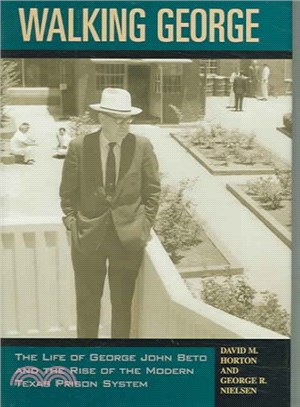Walking George ― The Life Of George John Beto And The Rise Of The Modern Texas Prison System
商品資訊
系列名:NORTH TEXAS CRIME AND CRIMINAL JUSTICE SERIES
ISBN13:9781574411997
出版社:Texas A & M Univ Pr
作者:David M. Horton; George R. Nielsen
出版日:2005/09/30
裝訂/頁數:精裝/257頁
規格:22.9cm*15.9cm*1.9cm (高/寬/厚)
商品簡介
作者簡介
相關商品
商品簡介
George John Beto (19161991) is best known for his contributions to criminal justice, but his fame is not limited to this field.Walking George, authored by two of his former students, David M. Horton and George R. Nielsen, examines the entire life of Beto and his many achievements in the fields of both education and criminal justiceand how he wedded the two whenever possible.
Beto initially studied to become a Lutheran pastor but instead was called to teach at Concordia Lutheran College in Austin, Texas. During his twenty years at that institution he became its president, expanded it into a junior college, racially integrated it, made it co-educational, and expanded its facilities. His successes convinced the administrators of the church to present him with a challenge to revitalize a seminary in Springfield, Illinois. He accepted the challenge in 1959, but after three years of progress, he left the seminary to become the head of the Texas Department of Corrections.
Although Beto had no real academic training in corrections and had never served in any administrative position in corrections, he had learned incidentally. During his last six years in Austin, he had served on the Texas Prison Board, a volunteer board that supervised the entire prison system. As a board member he established one of the earliest General Education Development testing programs for prisoners. Fortuitously, his years on the board came during the time when reform of the Texas prisons was the watchword.
During his ten-year term as the director of the Texas Department of Corrections, Beto continued the reform program. Most notable were his efforts at rehabilitation of the inmates and his attempt at refining a method of managing prisoners, called the Texas Control Model. He persuaded the Texas state legislature to enact a law requiring state agencies to purchase manufactured goods from state prisons, which tremendously expanded industry and training for inmates. In 1969, at Beto’s urging, the Windham school district for educating inmates became a reality, the first of its kind at any prison in the United States.
Beto’s predilection to show up on foot in front of a given Texas prison, at all hours of the day and night, ready for an inspection and tour, earned him the nickname Walking George.” After retiring as head of the Texas prison system in 1972, he became a professor at Sam Houston State University's College of Criminal Justice until 1991. His leadership and participation propelled it to become the most esteemed program in the country.
Beto’s personal force and unique accomplishments defined him as one of the premier American penologists of the twentieth century. This is the first in-depth biography of the man and his contributions.
Walking George, authored by two of his former students, David M. Horton and George R. Nielsen, examines the entire life of George John Beto (19161991) and his many achievements in the fields of both education and criminal justice. During his ten-year term as the director of the Texas Department of Corrections, Beto spearheaded many education and reform programs aimed at rehabilitating inmates, such as the Windham school district for educating inmates, the first of its kind at any prison in the United States.
Beto initially studied to become a Lutheran pastor but instead was called to teach at Concordia Lutheran College in Austin, Texas. During his twenty years at that institution he became its president, expanded it into a junior college, racially integrated it, made it co-educational, and expanded its facilities. His successes convinced the administrators of the church to present him with a challenge to revitalize a seminary in Springfield, Illinois. He accepted the challenge in 1959, but after three years of progress, he left the seminary to become the head of the Texas Department of Corrections.
Although Beto had no real academic training in corrections and had never served in any administrative position in corrections, he had learned incidentally. During his last six years in Austin, he had served on the Texas Prison Board, a volunteer board that supervised the entire prison system. As a board member he established one of the earliest General Education Development testing programs for prisoners. Fortuitously, his years on the board came during the time when reform of the Texas prisons was the watchword.
During his ten-year term as the director of the Texas Department of Corrections, Beto continued the reform program. Most notable were his efforts at rehabilitation of the inmates and his attempt at refining a method of managing prisoners, called the Texas Control Model. He persuaded the Texas state legislature to enact a law requiring state agencies to purchase manufactured goods from state prisons, which tremendously expanded industry and training for inmates. In 1969, at Beto’s urging, the Windham school district for educating inmates became a reality, the first of its kind at any prison in the United States.
Beto’s predilection to show up on foot in front of a given Texas prison, at all hours of the day and night, ready for an inspection and tour, earned him the nickname Walking George.” After retiring as head of the Texas prison system in 1972, he became a professor at Sam Houston State University's College of Criminal Justice until 1991. His leadership and participation propelled it to become the most esteemed program in the country.
Beto’s personal force and unique accomplishments defined him as one of the premier American penologists of the twentieth century. This is the first in-depth biography of the man and his contributions.
Walking George, authored by two of his former students, David M. Horton and George R. Nielsen, examines the entire life of George John Beto (19161991) and his many achievements in the fields of both education and criminal justice. During his ten-year term as the director of the Texas Department of Corrections, Beto spearheaded many education and reform programs aimed at rehabilitating inmates, such as the Windham school district for educating inmates, the first of its kind at any prison in the United States.
作者簡介
David M. Horton is professor and director of the Criminal Justice Program at St. Edward’s University, Austin, Texas. He obtained his doctor of philosophy degree in criminal justice from the Institute of Contemporary Corrections and Behavioral Sciences (now the George J. Beto Center for Criminal Justice) at Sam Houston State University in Huntsville, Texas, where he studied under Dr. Beto. He is the coauthor ofLone Star Justice: The Texas Criminal Justice System.
George R. Nielsen spent his entire career teaching in Lutheran schools, first in Houston and then, from 1959 to 1997, at Concordia University in River Forest, Illinois. His most recent book,Johann Kilian, Pastor, is a biography of the pastor of the Wends at Serbin, Texas. In 1995 Concordia University named him Distinguished Professor of History. He is now retired, living in the Black Hills of South Dakota.
George R. Nielsen spent his entire career teaching in Lutheran schools, first in Houston and then, from 1959 to 1997, at Concordia University in River Forest, Illinois. His most recent book,Johann Kilian, Pastor, is a biography of the pastor of the Wends at Serbin, Texas. In 1995 Concordia University named him Distinguished Professor of History. He is now retired, living in the Black Hills of South Dakota.
主題書展
更多
主題書展
更多書展今日66折
您曾經瀏覽過的商品
購物須知
外文書商品之書封,為出版社提供之樣本。實際出貨商品,以出版社所提供之現有版本為主。部份書籍,因出版社供應狀況特殊,匯率將依實際狀況做調整。
無庫存之商品,在您完成訂單程序之後,將以空運的方式為你下單調貨。為了縮短等待的時間,建議您將外文書與其他商品分開下單,以獲得最快的取貨速度,平均調貨時間為1~2個月。
為了保護您的權益,「三民網路書店」提供會員七日商品鑑賞期(收到商品為起始日)。
若要辦理退貨,請在商品鑑賞期內寄回,且商品必須是全新狀態與完整包裝(商品、附件、發票、隨貨贈品等)否則恕不接受退貨。
























